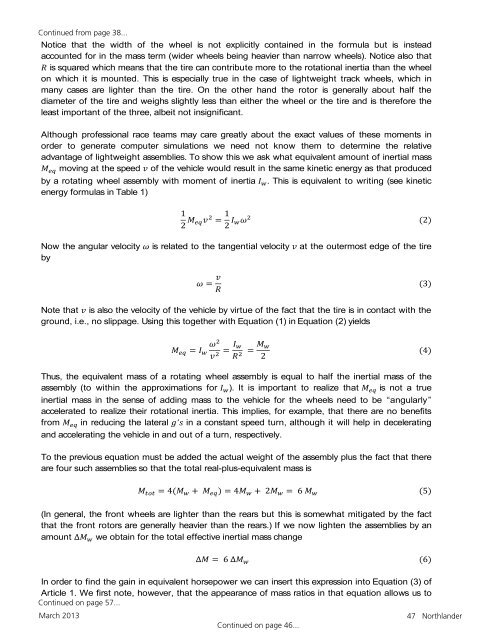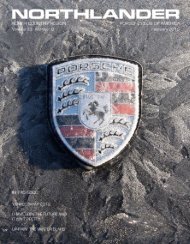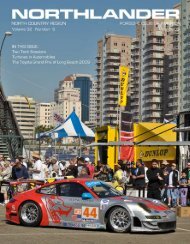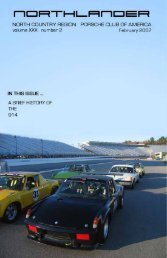1 Northlander March 2013 - North Country Region
1 Northlander March 2013 - North Country Region
1 Northlander March 2013 - North Country Region
You also want an ePaper? Increase the reach of your titles
YUMPU automatically turns print PDFs into web optimized ePapers that Google loves.
Continued from page 38...<br />
Notice that the width of the wheel is not explicitly contained in the formula but is instead<br />
accounted for in the mass term (wider wheels being heavier than narrow wheels). Notice also that<br />
is squared which means that the tire can contribute more to the rotational inertia than the wheel<br />
on which it is mounted. This is especially true in the case of lightweight track wheels, which in<br />
many cases are lighter than the tire. On the other hand the rotor is generally about half the<br />
diameter of the tire and weighs slightly less than either the wheel or the tire and is therefore the<br />
least important of the three, albeit not insignificant.<br />
Although professional race teams may care greatly about the exact values of these moments in<br />
order to generate computer simulations we need not know them to determine the relative<br />
advantage of lightweight assemblies. To show this we ask what equivalent amount of inertial mass<br />
moving at the speed of the vehicle would result in the same kinetic energy as that produced<br />
by a rotating wheel assembly with moment of inertia<br />
energy formulas in Table 1)<br />
. This is equivalent to writing (see kinetic<br />
Now the angular velocity is related to the tangential velocity at the outermost edge of the tire<br />
by<br />
Note that is also the velocity of the vehicle by virtue of the fact that the tire is in contact with the<br />
ground, i.e., no slippage. Using this together with Equation (1) in Equation (2) yields<br />
Thus, the equivalent mass of a rotating wheel assembly is equal to half the inertial mass of the<br />
assembly (to within the approximations for ). It is important to realize that is not a true<br />
inertial mass in the sense of adding mass to the vehicle for the wheels need to be “angularly”<br />
accelerated to realize their rotational inertia. This implies, for example, that there are no benefits<br />
from in reducing the lateral in a constant speed turn, although it will help in decelerating<br />
and accelerating the vehicle in and out of a turn, respectively.<br />
To the previous equation must be added the actual weight of the assembly plus the fact that there<br />
are four such assemblies so that the total real-plus-equivalent mass is<br />
(In general, the front wheels are lighter than the rears but this is somewhat mitigated by the fact<br />
that the front rotors are generally heavier than the rears.) If we now lighten the assemblies by an<br />
amount we obtain for the total effective inertial mass change<br />
In order to find the gain in equivalent horsepower we can insert this expression into Equation (3) of<br />
Article 1. We first note, however, that the appearance of mass ratios in that equation allows us to<br />
Continued on page 57...<br />
<strong>March</strong> <strong>2013</strong><br />
Continued on page 46...<br />
47 <strong><strong>North</strong>lander</strong>
















